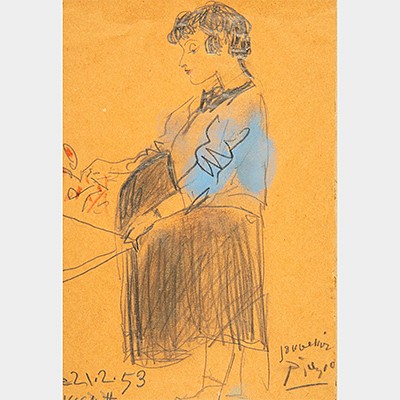JOAN MIRÓ I FERRÀ (Barcelona, 1893 - Palma de Mallorca, 1983). Untitled, ca. 1970. Pencil on paper. Attached ADOM certificate. Signed and dedicated to
Lot 87
About Seller
Setdart Auction House
Carrer Aragó 346
Barcelona
Spain
Setdart Subastas was born in 2004 and is currently the first online art auction in Spain with solidity, prestige and reliability guaranteed by our more than 60,000 users. Setdart has a young, dynamic and enterprising team ready to successfully manage the purchase and sale of art works through custom...Read more
Categories
Estimate:
EUR€10,000 - EUR€12,000
$10,416.67 - $12,500
Absentee vs Live bid
Two ways to bid:
- Leave a max absentee bid and the platform will bid on your behalf up to your maximum bid during the live auction.
- Bid live during the auction and your bids will be submitted real-time to the auctioneer.
Bid Increments
| Price | Bid Increment |
|---|---|
| EUR€0 | EUR€10 |
| EUR€200 | EUR€25 |
| EUR€500 | EUR€50 |
| EUR€1,000 | EUR€100 |
| EUR€3,000 | EUR€200 |
| EUR€5,000 | EUR€500 |
| EUR€10,000 | EUR€1,000 |
| EUR€20,000 | EUR€2,000 |
| EUR€50,000 | EUR€5,000 |
About Auction
By Setdart Auction House
Sep 20, 2021
Set Reminder
2021-09-20 08:00:00
2021-09-20 08:00:00
America/New_York
Bidsquare
Bidsquare : CONTEMPORARY ART
https://www.bidsquare.com/auctions/setdart-auction-house/contemporary-art-7482
Setdart Auction House sofia@setdart.com
Setdart Auction House sofia@setdart.com
- Lot Description
JOAN MIRÓ I FERRÀ (Barcelona, 1893 - Palma de Mallorca, 1983). Untitled, ca. 1970. Pencil on paper. Attached ADOM certificate. Signed and dedicated to Alfred Guillem in the lower margin. Measurements: 23 x 13.6 cm; 54 x 43 cm. (frame). This drawing belongs to a period of vital plenitude for Joan Miró, who in his old age remained deeply committed to the anti-Francoist struggle until the end of the dictatorship. By then he had travelled to Japan and the influence of Eastern philosophy increasingly permeated his plastic art. Joan Miró trained in Barcelona, between the Escuela de la Lonja and the Galí Academy. As early as 1918 he held his first exhibition at the Galerías Dalmau in Barcelona. In 1920 he moved to Paris and met Picasso, Raynal, Max Jacob, Tzara and the Dadaists. There, under the influence of the surrealist poets and painters, he gradually matured his style; he tried to transpose surrealist poetry to the visual, based on memory, fantasy and the irrational. From this point onwards his style began to evolve, leading him to more ethereal works in which organic forms and figures were reduced to abstract dots, lines and patches of colour. In 1924 he signed the first Surrealist manifesto, although the evolution of his work, which is too complex, makes it impossible to ascribe him to any particular orthodoxy. His third exhibition in Paris in 1928 was his first great triumph: the Museum of Modern Art in New York acquired two of his works. He returned to Spain in 1941, and that same year the museum devoted a retrospective to him which was to be his definitive international consecration. During the 1950s he experimented with other artistic media, such as engraving, lithography and ceramics. From 1956 until his death in 1983, he lived in Palma de Mallorca in a sort of internal exile, while his international fame grew. Throughout his life he received numerous awards, such as the Grand Prizes at the Venice Biennale in 1954 and the Guggenheim Foundation in 1959, the Carnegie Prize for Painting in 1966, the Gold Medals of the Generalitat de Catalunya (1978) and of the Fine Arts (1980), and was named Doctor Honoris Causa by the universities of Harvard and Barcelona. Today his work can be seen at the Joan Miró Foundation in Barcelona, inaugurated in 1975, as well as in major contemporary art museums around the world, such as the Thyssen-Bornemisza, the MoMA in New York, the Reina Sofía Museum in Madrid, the National Gallery in Washington, the MNAM in Paris and the Albright-Knox Art Gallery in Buffalo.
- Shipping Info
-
In-house shipping available. Please inquire at admin@setdart.com.
-
- Buyer's Premium



 EUR
EUR CAD
CAD AUD
AUD GBP
GBP MXN
MXN HKD
HKD CNY
CNY MYR
MYR SEK
SEK SGD
SGD CHF
CHF THB
THB













